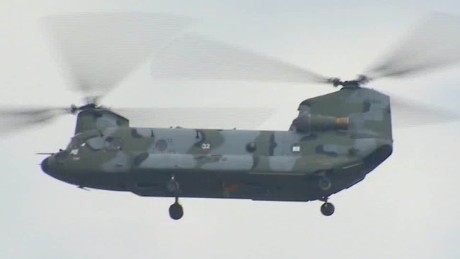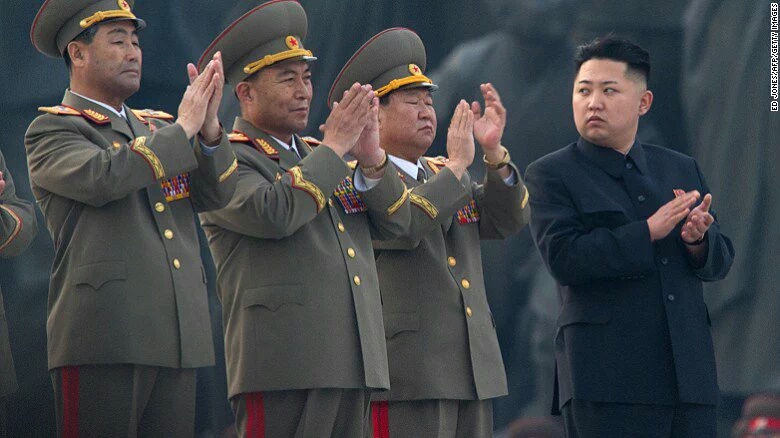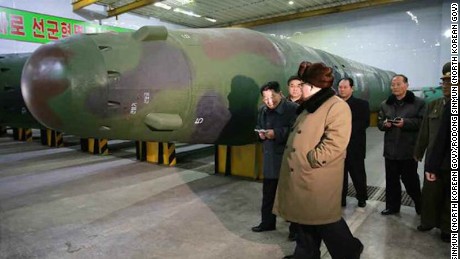
WORLD
North Korea Claims To Have Nuclear Warheads That Can Fit On Missiles

North Korea claims to have miniaturized nuclear warheads to fit on ballistic missiles, state-run Korea Central News Agency reported.
The report comes after the country reported a successful test of what it said was a hydrogen bomb in February and as tensions on the peninsula remain high as joint U.S.-South Korean military exercises take place.
State media reported Wednesday that North Korean leader Kim Jong Un met with nuclear scientists and technicians who briefed him on “research conducted to tip various type tactical and strategic ballistic missiles with nuclear warheads.”
The agency also published photographs that appeared to show Kim visiting a facility where the warheads have been made to fit on ballistic missiles — the first time state media has released images showing its miniaturized weapons technology. CNN cannot independently confirm the photos veracity or the claims of KCNA.
David Albright of the Institute for Science and International Security told CNN’s Brian Todd on Monday that his group thinks the North Koreans had probably already miniaturized a warhead.South Korean Defense White Paper from 2014 also noted that its neighbor’s ability to miniaturize nuclear weapons seemed, at the time, “to have reached a considerable level.”
While there are concerns about the progress being made, analysts say that the reclusive nation does not yet have the ability to launch a strike on U.S. soil.
“They don’t have a proven ICBM capability and a warhead that could survive re-entry as I understand it,” Bonnie Glaser, senior adviser for Asia at the Center for Strategic and International Studies, told CNN by phone from Tokyo.
“So there are probably some technical difficulties there for hitting the United States.
“The point here is that with every test, the North Koreans are going to learn something and they’re going to make progress. And we probably should not underestimate their capability … if not today, then tomorrow.”
Escalation on the peninsula
The news comes as tensions are once again heightened on the Korean Peninsula, with the United States and South Korea conducting what has been described by a South Korean Defense Ministry spokesman as the “largest ever” joint military exercises, in which around 17,000 U.S. military personnel are participating alongside some 300,000 South Korean troops, according to U.S. Forces Korea.
North Korea on Sunday warned it would make a “pre-emptive and offensive nuclear strike” in response to the joint exercises.
The military spokesman said that the two allies were “closely monitoring” signs of North Korean provocation.
“As of now, there are no direct sign of provocation, but we are planning to continuously strengthen surveillance,” South Korean Defense Ministry spokesman Moon Sang-gyun said.
South Korea said it is keeping an eye on the situation with the help of U.S. intelligence authorities.
“South Korean Defense Ministry assesses North Korea, at this point, has not secured the capability of miniaturizing a nuclear warhead nor does it have actual combat capability of KN-08,” South Korea’s Defense Ministry said.
Analysts are questioning the wisdom of expansion of the annual exercises at a time when Pyongyang’s nuclear ambitions look as advanced as ever seen.
“I didn’t see the logic of expanding the exercises,” Stephan Haggard, professor at the School of Global Policy and Strategy, University of California, San Diego, and one of the authors of the North Korea: Witness to Transformation blog told CNN.
“I personally think that upping the sizes of the (joint U.S.-South Korea military) exercises didn’t serve any material function. It’s not clear that the size will bring North Korea back to the diplomatic table, so there’s no real purpose to do that.
“All you’ve done is stir the viper’s next. And the North Korean military and the leadership I’m sure is extremely nervous. Because it’s coming in the context of the sanctions, and the Chinese are clearly displeased.”
The North Korean warning also follows last week’s sanctions announced by the 15-member U.N. Security Council, which Pyongyang has denounced as “unprecedented and gangster-like.”
Bomb test
Discussions about new sanctions started after North Korea claimed to have successfully tested a hydrogen bomb in January, its fourth nuclear test.
Then, in February, Pyongyang said it had successfully launched an Earth satellite into orbit via the long-range Kwangmyongsong carrier rocket.
How close is North Korea to weaponizing a rocket?
The Security Council called those moves “violations and flagrant disregard” of previous resolutions.
On Friday, KCNA reported that Kim said his country’s “nuclear warheads need to be ready for use at any time.”
“Under the extreme situation that the U.S. imperialist is misusing its military influence and is pressuring other countries and people to start war and catastrophe, the only way for our people to protect sovereignty and rights to live is to strengthen the quality and quantity of nuclear power and realize the balance of power,” Kim said, according to KCNA.
This rhetoric came out a day after the news agency reported tests of a new multiple-launch rocket system. This may or may not be referring to a launch of “short-range projectiles” chronicled one day earlier by the South Korean Joint Chiefs of Staff.
Pyongyang has long boasted about its nuclear ambitions, about as long as South Korea and the United States have sought to derail them. The issue has only furthered the isolation of North Korea, a communist, closed-off state led for decades by the authoritarian Kim, his late father and his grandfather.
A chief concern is not only that Pyongyang will develop effective nuclear warheads, but that they’ll pair them with missiles that can strike targets around East Asia and perhaps beyond.
NEWS
Tinubu Congratulates Tunde Onakoya On New World Chess Record
By Ebriku John Friday
President Bola Tinubu congratulates Mr. Tunde Onakoya on setting a new world chess record and sounding the gong of Nigeria’s resilience, self-belief, and ingenuity at the square of global acclaim

World Chess King Tunde Onakoya
.
Mr. Onakoya broke the Guinness World Record for the longest chess marathon on Saturday, after playing for over 58 hours and winning every match in tow.
Chief Ajuri Ngelale Special Adviser to the President (Media & Publicity) disclosed this on Saturday in a statement made available to journalists in Abuja.
President Tinubu celebrates the Nigerian Chess Champion and founder of Chess in Slums Africa for the rare feat, but especially for the reason driving this compelling demonstration of character, which is raising funds for African children to learn and find opportunity through chess.
The President states Mr. Onakoya has shown a streak customary among Nigeria’s youth population, the audacity to make good change happen; to baffle impossibility, and propel innovations and solutions to the nation’s challenges, even from corners of disadvantage.
The President affirms that Nigeria’s youths have demonstrated in all fields, including Afrobeats, Nollywood, the pulsating skit-making enterprise, education, science, and technology, that great exploits can truly come from small quarters.
President Tinubu commends the inclination of Nigerians – across artificial partitions – for unity, once again exemplified through their undiluted support for this epoch-making endeavour.
The President assures all citizens that his administration remains strongly committed to creating and expanding opportunities for the youth to explore and exercise their abilities and become the symbols of greatness our nation represents into the future.
WORLD
World Bank: UNAIDS Calls For Sustained And Expanded health and HIV investments
|
NEWS
Guinness World Record: Nigerians Cheer Onakoya As 58-Hour Chess Marathon Begins In New York

Nigerians abroad have come out to support renowned chess master, Tunde Onakoya, as he embarks on a mission to surpass the Guinness World Record for the longest chess marathon.
Onakoya announced the commencement of the marathon via his X account with the caption, “Game time.”
He also wrote, “We haven’t even started yet and Nigerians are already trooping in to camp out with me.”
Among those cheering Onakoya is Nigerian singer, Adekunle Kosoko, popularly known as Adekunle Gold.
The event, which is underway at New York City’s iconic Times Square, started at 10am on Wednesday, April 17, and is scheduled to end at 8pm on April 19.
Onakoya is set to engage in an intense chess marathon, aiming to play for 58 hours without a single defeat.
The current Guinness World Record, set by Hallvard Haug Flatebø and Sjur Ferkingstad of Norway on November 11, 2018, stands at 56 hours, 9 minutes, and 37 seconds.

Credit: X | Tunde_OD
—
Follow us for more breaking news and videos







